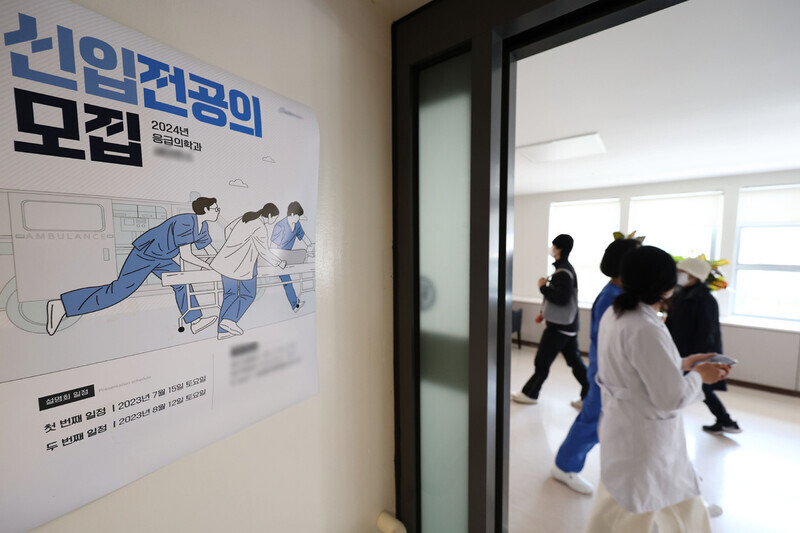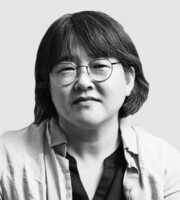hankyoreh
Links to other country sites 다른 나라 사이트 링크
[Guest essay] How Korea turned its trainee doctors into monsters


By Kim Myoung-hee, preventive medicine specialist and steering committee chair of Solidarity for Worker’s Health
In 2015 the International Labour Organization published a working paper on the work hours of health workers and the effects of their work hours. I was in charge of researching the situation on the ground in South Korea. A medical intern I interviewed at the time told me, “After a night shift, my mental calculations and decision-making capacity slow down. I feel dazed, and it’s difficult to understand what other people are saying to me. My body feels slow.”
A representative of a patient advocacy group told me, “Critical care patients, cancer patients, and those suffering from rare diseases are usually treated by interns and residents. But they often look sleepy. You can’t help but feel uneasy.”
According to a 2022 study conducted by the Korean Intern Resident Association (KIRA), a medical resident’s or intern’s average work week was 77.7 hours. Among study participants, 25% of them worked 100 hours or more per week. In 2016, South Korea revised labor laws regarding medical interns and residents to set a cap of 80 hours per week, yet this seems to have been nothing more than a paper revision.
Why do interns and residents continue to be overworked? It’s all about hospitals’ bottom lines. Hospitals exploit residents and interns’ cheap labor by making them work long hours. The exploitation is justified by categorizing them as “trainee doctors.” Education, not exploitation, is the reason for their long hours, they say.
In February, over 11,900 medical residents and interns abandoned their posts to protest the government’s policies on healthcare and medical school admissions. Teaching hospitals took a major hit. Compared to the same period last year, 50 of these teaching hospitals recorded profits reduced by 423.8 billion won (US$308.4 million), or 15.9%. The “Big 5” hospitals saw even greater losses. The walkouts resulted in sharp reductions in outpatient care and a reduction of general hospital beds by 50% to 60%.
Several hospitals are now in emergency operation mode. Some have forced their employees to take unpaid leave. Some have even demanded that employees return their monthly salaries to management. Some are actively calling for voluntary resignations.
Hospital managers are not the only people who are worried. Patients are worried that they won’t be able to receive the treatment they need at the right time. With a walkout of 12,000 workers, the industry is suffering a national health care crisis, with even the nation’s largest hospitals in financial trouble. The level of damage that the residents and interns have inflicted is unprecedented in any industry.
How did we get to the point where the stability of our national health care system is dependent on 12,000 young doctors in training? First, South Korea’s health care resources are excessively concentrated in major hospitals, and these institutions rely excessively on the labor of interns and residents. Among some 7,000 doctors at the Big 5, 39% of them are residents or interns. At Seoul National University Hospital, that figure shoots up to 46.2%. In countries like the US and Japan, the figure is closer to 10%. Instead of viewing them as investments that require time, resources and training, Korean hospitals view interns and residents as nothing more than low-cost labor. Now, our hospitals are reaping what they sowed.
According to a 2020 study on the state of health care workers, medical interns and residents received salaries that corresponded to only 30% of the average annual salary of specialists. The justification is that they’re still trainees, and have yet to acquire the expertise necessary to become a specialist. Even the relevant legislation regarding medical interns and residents uses language like “training hours” instead of “work hours” to create a loophole that allows them to be worked to the bone.
While other industries usually set a mandatory minimum of training hours worked to gain certifications or qualifications, the health care industry merely sets a maximum of training hours. This is clearly nothing more than a technical circumvention of labor laws that would otherwise prevent our interns and residents from working such grueling hours.
But it was none other than the government and hospitals that afforded Korea’s residents and interns such immense power. While medical school faculty declared that they would not sit idly by if the trainee doctors on walkouts faced consequences, these senior doctors — whether they’re keen to admit it or not — have until now effectively played the role of middle managers in this chain of exploitation.
Meanwhile the hospitals at the crux of this whole crisis are acting as though they are innocent bystanders caught in the crossfire of a conflict between the government and physicians, seamlessly passing the buck on to yet another group of health care workers. University-affiliated hospitals in the greater Seoul area plan to compete to set up branches in the surrounding areas by 2028, yet still they have no plans to change this inexplicable labor force system that has proven to be overly reliant on residents and interns.
And undergirding all this, there’s the culpability of the state for sitting on its hands about the commercialization of health care and its transformation into a market, which is what drove things to this point.
It’s far past time to change this system. Our society has paid the price to learn this lesson. Training medical interns and residents should never be considered in terms of profitability. Rather, we should consider these trainees to be investments, and concern ourselves with the costs of such an investment. Teaching hospitals need to vastly increase the number of specialists on staff and return interns and residents to their rightful position as students getting their education.
At the same time, tertiary hospitals that are equipped to provide the highest levels of care need to give up their obsession with expanding their reach which has them competing for outpatient care with local clinics and publicly run medical centers. Moreover, in the interest of socially fostering the professional workforce that Korea needs when it comes to health care, the government must invest in the education and training of interns and residents and have public oversight over them.
In the end, the solution to this health care crisis that Korea now faces lies in stepping up the state’s role in health care provision and education of future doctors, making it a public matter rather than a private one.
Please direct questions or comments to [english@hani.co.kr]

Editorial・opinion
![[Column] Tariffs on China: Trump was dumb, Biden dumber [Column] Tariffs on China: Trump was dumb, Biden dumber](https://flexible.img.hani.co.kr/flexible/normal/500/300/imgdb/original/2024/0520/191716191153918.jpg) [Column] Tariffs on China: Trump was dumb, Biden dumber
[Column] Tariffs on China: Trump was dumb, Biden dumber![[Column] What if Seoul took reunification by force off the table? [Column] What if Seoul took reunification by force off the table?](https://flexible.img.hani.co.kr/flexible/normal/500/300/imgdb/original/2024/0520/3017161928630494.jpg) [Column] What if Seoul took reunification by force off the table?
[Column] What if Seoul took reunification by force off the table?- [Editorial] Intensifying US-China rivalry means Seoul must address uncertainty with Beijing sooner than later
- [Column] When ‘fairness’ means hate and violence
- [Editorial] Yoon must stop abusing authority to shield himself from investigation
- [Column] US troop withdrawal from Korea could be the Acheson Line all over
- [Column] How to win back readers who’ve turned to YouTube for news
- [Column] Welcome to the president’s pity party
- [Editorial] Korea must respond firmly to Japan’s attempt to usurp Line
- [Editorial] Transfers of prosecutors investigating Korea’s first lady send chilling message
Most viewed articles
- 1To weigh costs and benefits, Korea must stop treating US troop presence as a sacred cow
- 2Kim Jong-un wanted to meet with residents of shelled Yeonpyeong Island in South, Moon recalls in mem
- 3Xi, Putin ‘oppose acts of military intimidation’ against N. Korea by US in joint statement
- 4Berlin mayor hints at tearing down ‘comfort women’ memorial in city
- 5[Column] What if Seoul took reunification by force off the table?
- 6[Column] Tariffs on China: Trump was dumb, Biden dumber
- 7[Editorial] Transfers of prosecutors investigating Korea’s first lady send chilling message
- 8For new generation of Chinese artists, discontent is disobedience
- 9New doc undoes stereotypes of N. Korea with candid portraits of women’s football legends
- 10[Column] In Germany, Japan is waging a war over its history with Korea